The Black Shark, scientifically known as Labeo chrysophekadion, is a distinctive freshwater fish, most commonly found in the rivers of Southeast Asia. Recognised for its striking dark colour and unique shovel-shaped snout, this species is often mistaken for the Black Shark Minnow, yet they are distinctly different.
One rare and intriguing feature of the Black Shark is its ability to modify its colour intensity according to its mood and environment. As an active bottom dweller, it plays an essential role in its natural habitat. Proper care, diet, and attention to water conditions are crucial to maintaining this remarkable fish in home aquariums, making it a challenging yet rewarding experience for enthusiasts.
Table of Contents
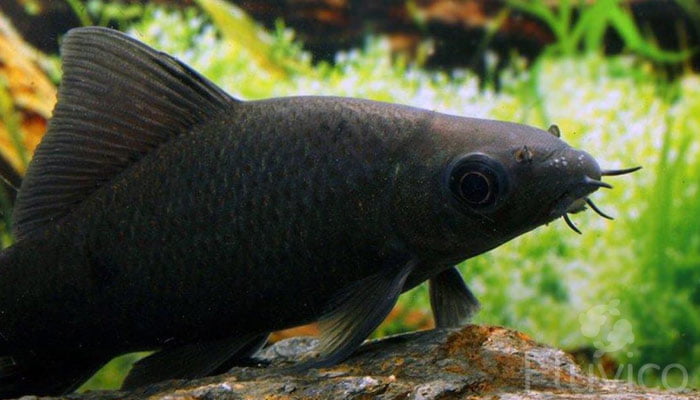
Stats and Details
| Black Shark Fact: | Details: |
| Scientific Name: | Labeo chrysophekadion |
| Other Names: | Black Sharkminnow, Black Labeo |
| Care Level: | Moderate to Difficult |
| Native Region: | Freshwater regions of Southeast Asia |
| Lifespan: | Up to 10 years in optimal conditions |
| Size: | Up to 90 centimetres |
| Family: | Cyprinidae |
| Diet: | Omnivore |
| Minimum Tank Size: | 750 litres for a single fish |
| Compatibility: | Semi-aggressive: Best with larger, non-aggressive species |
Origin and Distribution
The Black Shark originates from the tropical rivers and streams of Southeast Asia, primarily found in countries like Thailand, Cambodia, and Indonesia. Its unique preference for flowing waters, surrounded by dense vegetation, sets it apart from other freshwater species.
What’s rare about this fish is its limited distribution, making it a fascinating yet lesser-known species even among fish keepers. Unlike other aquatic species that have adapted to various environments, the Black Shark’s specific habitat needs have kept it confined to its native regions.
Understanding its origin and distribution is vital for proper care and conservation, reflecting a delicate balance with its natural surroundings. Its sensitivity to habitat changes highlights the importance of responsible environmental stewardship.
Natural Habitat
The Black Shark’s natural habitat is a marvel in itself, reflecting a preference for flowing waters in the tropical rivers and streams of Southeast Asia. Nestled within these waters, the Black Shark thrives in areas replete with dense vegetation, submerged wood, and overhanging branches.
This specific environment preference provides it with shelter, ample feeding opportunities, and the right water conditions. What’s unique about this species is its rare ability to adapt to seasonal changes within its habitat, such as monsoons, which may cause fluctuations in water parameters. Understanding and replicating these conditions is essential for successful care and maintenance of this fish in domestic aquariums.
Black Shark Physical Characteristics
Size, Lifespan and Physical Characteristics
The Black Shark is a truly distinctive freshwater fish, marked by its dark colouration and a unique shovel-shaped snout. Growing up to 90 centimetres in length, this species presents an impressive size for an aquarium fish. Its strong jaw, designed for grazing on algae, coupled with a long, streamlined body, adds to its allure.
One remarkable aspect of the Black Shark is its lifespan, which can extend up to 10 years under proper care. These characteristics not only make it a fascinating subject for those interested in aquatic life but also demand attention to detail in its care and maintenance for optimal well-being.
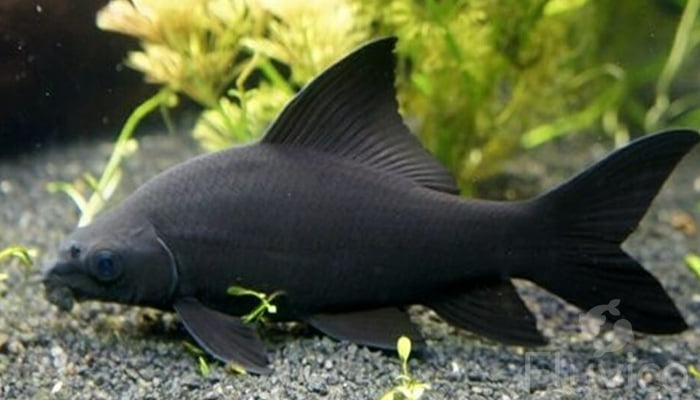
Sexual Dimorphism
Sexual dimorphism in the Black Shark is a subtle yet intriguing aspect of its biology. While males and females may appear similar in general appearance, close observation reveals differences. Males are typically slimmer and more streamlined, whereas females are generally more robust and rounded, especially during breeding seasons.
These distinctions, though not pronounced, are crucial for breeders and those interested in the reproductive behaviour of this species. Understanding sexual dimorphism in the Black Shark is essential for proper care and breeding, reflecting a nuanced appreciation of its natural characteristics. This aspect adds another layer of complexity and fascination to the study and care of this remarkable fish.
Behaviour and Compatibility
Behaviour and compatibility are central aspects in understanding the Black Shark’s care in an aquarium setting. Known for its assertive and territorial nature, the Black Shark may not be suitable for a community tank with small or timid fish. Compatibility with similarly-sized or more robust species is generally more successful.
It’s advisable to provide enough space and hiding spots to minimise aggression. Observing and understanding the Black Shark’s behaviour helps in selecting appropriate tank mates, ensuring a harmonious environment. Careful planning and consideration in this area can lead to a thriving and balanced aquarium, reflecting the species’ natural interactions.
Aquarium Setup for Black Shark
Aquarium Size
When it comes to housing the Black Shark, the choice of aquarium size is a critical aspect. Due to its significant growth potential, reaching up to 90 centimetres in length, the Black Shark requires a spacious environment to thrive. An aquarium of at least 700-800 litres is typically recommended for a single Black Shark, allowing ample space for swimming and replicating its natural habitat.
Smaller tanks can lead to stress and health issues for this remarkable fish. The substantial aquarium size not only ensures the well-being of the Black Shark but also offers an opportunity to create a visually appealing aquatic landscape for those interested in mimicking the species’ natural surroundings. 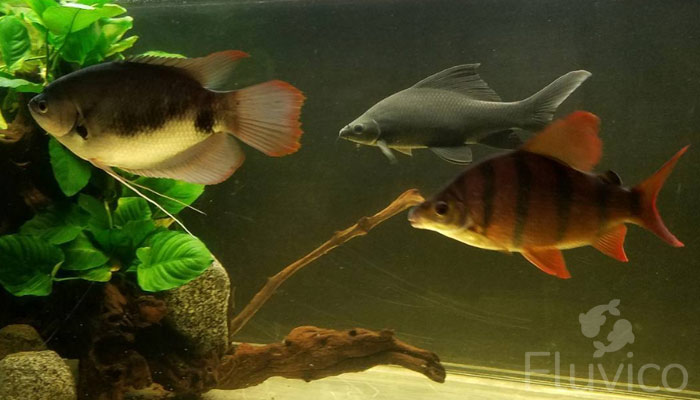
Water Requirements and Conditions
The Black Shark’s water requirements and conditions are specific and tailored to mirror its natural habitat in the flowing rivers of Southeast Asia. Ensuring these conditions is paramount for the fish’s health and well-being. Proper water conditions and aquarium setup include:
- Temperature: Ranging from 22 to 28°C, simulating its tropical environment.
- pH Level: Maintaining a slightly acidic to neutral pH of 6.5 to 7.5.
- Water Hardness: Soft to moderately hard water, with a hardness of 5 to 12 dGH.
- Filtration: Effective filtration to replicate the clean, flowing water found in its natural habitat.
- Water Change: Regular weekly water changes of about 25% to preserve water quality.
- Lighting: Moderate lighting that mimics the dappled sunlight of its native streams, promoting natural behaviour.
Tank Decoration and Compatible Plants
Creating a suitable tank environment for the Black Shark requires careful selection of decorations and compatible plants that resemble its natural habitat in Southeast Asia’s rivers. Attention to these elements not only adds to the tank’s aesthetics but also supports the fish’s natural behaviours. Key considerations include:
- Plants: Incorporating compatible plants such as Java Fern, Anubias, Vallisneria, Amazon Sword, Water Wisteria, Java Moss, Cryptocoryne, and Hornwort. These plants are known for their hardiness and suitability with the Black Shark’s tendency to graze.
- Substrate: Using a blend of fine gravel and sand to simulate natural riverbeds, encouraging the Black Shark’s natural foraging behaviour.
- Rocks and Driftwood: Adding features like natural rocks and driftwood to recreate its native environment, offering hiding spots and visual intrigue.
- Lighting: Implementing soft, dappled lighting to mimic the sunlight found in its riverine habitat.
- Open Spaces: Maintaining ample open swimming areas, essential for a fish of its size, without overcrowding with decorations.

Maintenance
Maintaining a Black Shark’s tank involves regular attention to ensure the aquarium’s cleanliness and stability, replicating the fish’s natural habitat. Effective maintenance practices not only promote the health and well-being of the Black Shark but also enhance the overall appearance of the tank. Key maintenance tasks include:
- Water Change: Regular weekly changes of around 25% of the water to maintain water quality and stability.
- Filtration: Ensuring proper filtration to keep the water clean and clear, mirroring the flowing water of its native environment.
- Plant Care: Regular trimming and care of the plants to prevent overgrowth and maintain their health.
- Substrate Cleaning: Periodic cleaning or vacuuming of the substrate to remove debris and uneaten food.
- Equipment Check: Routine inspection of heaters, filters, and other equipment to ensure they are functioning properly.
- Monitoring: Continuous monitoring of water parameters like pH, temperature, and hardness, making adjustments as needed.
Black Shark Care
Diet and Feeding
Feeding the Black Shark requires an understanding of its natural diet in the wild, consisting mainly of plant material and small invertebrates. Providing a balanced and varied diet promotes the health and vitality of the Black Shark. Key considerations for diet and feeding include:
- Vegetables: Incorporating leafy greens and aquatic plants, which form the staple of their diet.
- Protein: Offering occasional protein sources like brine shrimp, bloodworms, or insect larvae.
- Commercial Foods: Utilising specially formulated sinking pellets or algae wafers designed for herbivorous fish.
- Feeding Schedule: Regular feeding, usually once or twice a day, without overfeeding.
- Supplements: Considering additional vitamins or minerals if needed to ensure a well-rounded diet.
- Monitoring: Observing the fish’s eating habits and adjusting the diet accordingly, to avoid potential health issues.
A mindful approach to the Black Shark’s diet and feeding practices, emphasising variety and balance, plays a vital role in maintaining the fish’s health and mimicking its natural eating habits.
Black Shark Tank Mates
Choosing suitable tank mates for the Black Shark involves understanding its territorial nature and preferences. While compatibility with certain fish is possible, others must be avoided to prevent conflicts. Considering other sharks such as the rainbow shark, bala shark, Colombian shark, and red tail shark may lead to compatibility challenges due to similarities in behaviour and habitat requirements.
- Large Barbs and Loaches: Such as Tinfoil Barb, Tiger Barb, and Clown Loach.
- Robust Cichlids: Including Oscar, Jack Dempsey, and African Cichlids.
- Giant Gouramis: Including species like the Giant Gourami and Three Spot Gourami.
- Catfish Species: Like the Common Pleco or Red Tail Catfish.
- Large Characins: Such as Black Pacu and Silver Dollar.
- Crustaceans: Larger species of crabs that are not at risk of predation.
- Other Large Non-Aggressive Species: Including Freshwater Archerfish and Bichir.
Tank Mates to Avoid:
- Small or Timid Fish: Like Neon Tetras, Guppies, and Dwarf Rasboras, which can be threatened by the Black Shark.
- Crabs and Shrimp: Small crustaceans that may become prey.
- Other Shark Species: Including Rainbow Shark, Bala Shark, Columbian Shark, Red Tail Shark, and even other Black Sharks due to territoriality.
- Species Requiring Different Water Conditions: Those needing significantly different pH, temperature, or hardness levels.
It’s important to note that keeping multiple Black Sharks in the same tank can lead to increased aggression and competition. A careful balance and understanding of the individual species, their behaviours, and requirements are key to achieving a harmonious tank environment with the Black Shark.
Common Health Concerns
- Ich or White Spot Disease: Small white spots on the body, fins, and gills; behavioural changes may include scratching against objects.
- Fin Rot: Fins appear ragged or frayed; fish may become lethargic or less active.
- Swim Bladder Disorder: Difficulty in swimming, floating on one side, or swimming at odd angles; changes in normal swimming patterns.
- Bacterial Infections: Ulcers, sores, or red streaks on the body; fish may exhibit sluggishness or a loss of appetite.
- Parasitic Infections: Weight loss, visible worms or parasites; abnormal behaviour like erratic swimming or rubbing against surfaces.
- Dietary Issues: Constipation or bloating; changes in eating habits or unusual inactivity.
By paying close attention to both the appearance and behaviour of the Black Shark, aquarists can detect early signs of these common health concerns, thereby facilitating timely intervention and care.
Breeding Black Sharks
Breeding Black Sharks (Labeo chrysophekadion) in a home aquarium setting can be a challenging endeavour, primarily because of their size, territorial nature, and the specific conditions required. Here’s a concise guide to understanding the process: Maturity:
- Black Sharks generally reach sexual maturity around the size of 15-20 inches.
Sexual Dimorphism:
- Males usually have a slimmer body and brighter coloration when compared to the females.
- Females tend to have a fuller and rounder abdomen, especially when they are carrying eggs.
Spawning Environment:
- Given their territorial nature, it’s crucial to provide a large enough space to allow territories to be established.
- A sandy or fine gravel substrate is preferred for potential egg-laying.
- Plants or other forms of cover can encourage spawning as they provide a sense of security.
Courtship and Spawning:
- During courtship, males may chase females around the tank.
- The female will lay her eggs on the substrate, which the male will then fertilize.
Post-Spawning:
- Black Sharks are not known to exhibit parental care. There’s a risk they may consume the eggs or fry. Therefore, it’s a good practice to separate the eggs or the young from the adults.
- Eggs generally hatch within a few days, depending on the water temperature.
Feeding the Fry:
- Initially, Black Shark fry can be fed infusoria or liquid fry food.
- As they grow, they can be introduced to newly hatched brine shrimp and then gradually to other staple diets.
Challenges:
- Breeding Black Sharks commercially or in home aquariums is relatively rare, likely because of the specific conditions and space required.
- Their territorial and aggressive nature during the breeding phase can make the process demanding.
Recommendation: Breeding Black Sharks is best suited for experienced aquarists who can provide the necessary conditions and are prepared for the challenges it entails. If successful, the experience can indeed be rewarding, offering a unique opportunity to observe and engage with the life cycle of this fascinating species. 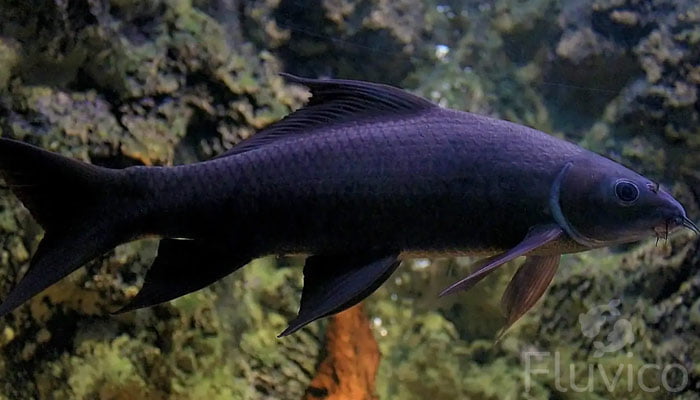
Should you get a Black Shark for your Aquarium?
If you’re considering adding a Black Shark to your aquarium, weighing the pros and cons can help you make an informed decision. Here’s an overview: Pros:
- Striking Appearance: Black Sharks are known for their beautiful, sleek black coloration and can be a stunning centrepiece in a large aquarium.
- Hardy Species: With proper care and suitable water conditions, Black Sharks tend to be robust and may be less susceptible to common fish diseases.
- Active and Engaging: They often display engaging behaviours and are active swimmers, providing visual interest.
- Herbivorous Diet: Their primarily vegetarian diet can help in controlling algae in the tank.
Cons:
- Size and Tank Requirements: Black Sharks can grow quite large, requiring a spacious tank, possibly upwards of 700 litre (200 gallons). This might not be suitable for every aquarist.
- Territorial Behaviour: They are known for their territorial nature, especially with other sharks or similarly sized fish, which can make selecting compatible tank mates challenging.
- Not Ideal for Community Tanks: Their assertiveness might not make them suitable for tanks with small or timid fish.
- Specialized Care Needs: Though considered hardy, they do require specific water conditions, diet, and a carefully planned environment, which might be challenging for beginners.
Getting a Black Shark for your aquarium can be a rewarding experience if you’re prepared to meet its specific needs and are aware of its particular characteristics. The striking appearance and engaging behaviours can make it an appealing choice for many.
However, considerations regarding its size, temperament, and care requirements might make it a less suitable option for inexperienced aquarists or those with smaller community tanks. Careful planning, understanding the species’ needs, and a willingness to provide the necessary environment can lead to a successful experience with the Black Shark.
FAQ
Are Black Sharks aggressive?
Yes, black sharks can be territorial and aggressive, especially towards smaller fish and others of their kind. They’re best suited for larger tanks with compatible tank mates.
How big does a Black Shark get?
Black sharks can reach lengths of up to 3 feet (0.91 metres) when fully grown. Proper tank size and care are essential for their growth and well-being.
Do Black Sharks bite?
While black sharks can be territorial and aggressive, they typically don’t “bite” humans like marine sharks. However, they can nip or show aggression towards other fish in the tank.
Why is my Black Shark not moving?
Potential reasons include water conditions, illness, stress, inadequate diet, or low oxygen. Monitoring environment and consulting a fish expert is essential for your black shark’s health.
More Reading

15 Types of Cryptocoryne: Which is Best For Your Aquarium Setup?

16 Awesome Low Light Aquarium Plants (Mosses, Ferns & Stem Plants)


18 Types of Aquarium Moss: Photos, Care, Propagation & Growth Guide
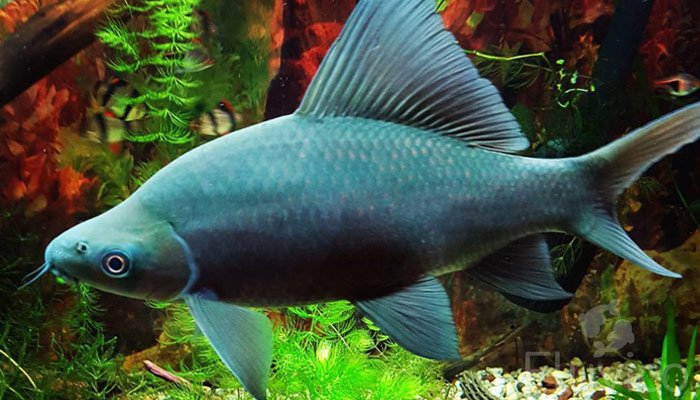


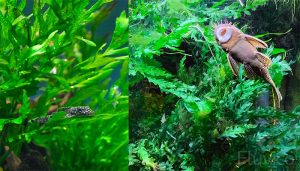


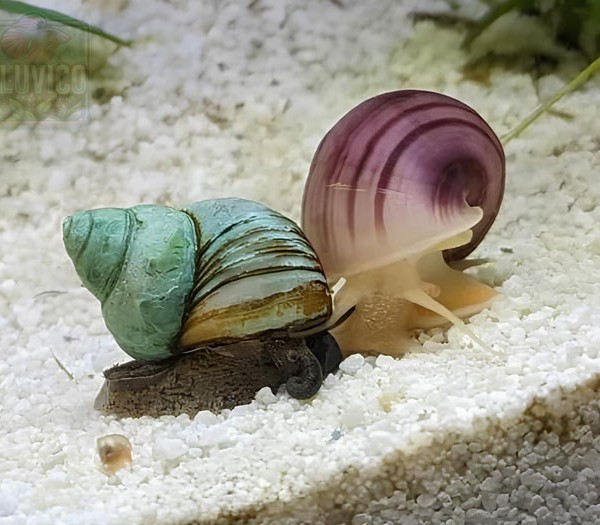

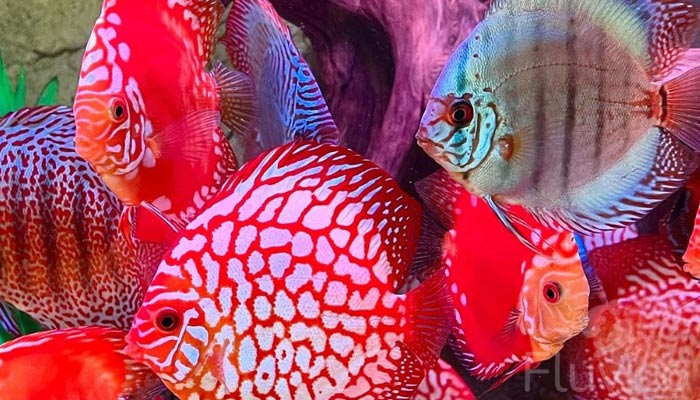

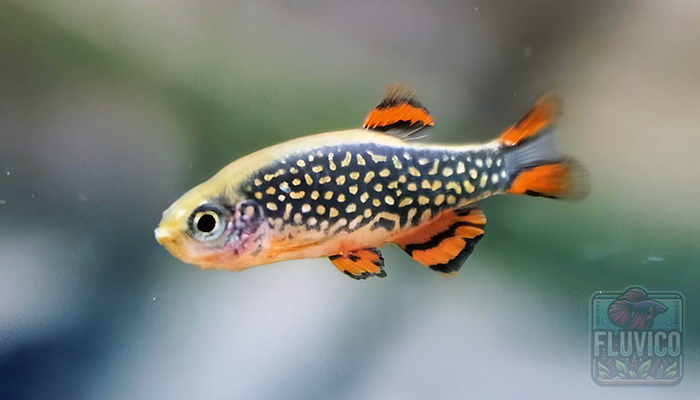
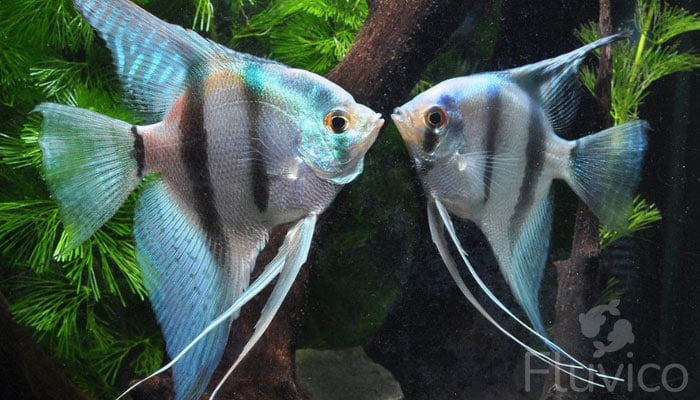
Hope you enjoyed our Black Shark Care Guide!
If you have any questions? Ask away, we’re here to help!
All the best,
Daniel